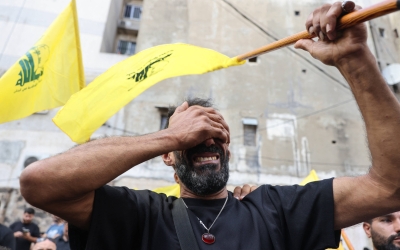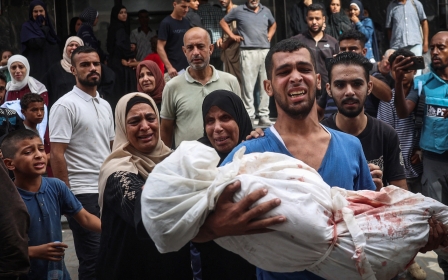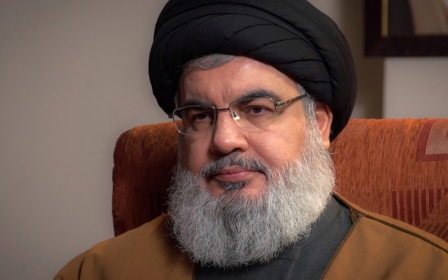Israel has opened a new front in Lebanon on a war it cannot end

Last week, Israel’s series of indiscriminate attacks on Lebanon, including the blowing up of communication devices, and air strikes on Beirut’s suburb of Dahiyeh, dealt a heavy blow to Hezbollah.
In addition to the high casualty rates among civilians, the attacks killed dozens of Hezbollah fighters, including top commanders of the elite Radwan unit.
On Monday, Israel escalated its attacks by launching heavy bombardment of south Lebanon and the Bekaa valley killing and injuring over 1000 civilians in a few hours.
The ability of Israel to infiltrate Hezbollah’s communications network and eliminate top military leaders cast serious doubts on the armed resistance’s capacity to operate efficiently on the battlefield. Intelligence failures can be deadlier than field losses for the overall conduct of the war.
The rate of these incidents has increased since the suspicious death of former Iranian President Ebrahim Raisi in a plane crash in May.
New MEE newsletter: Jerusalem Dispatch
Sign up to get the latest insights and analysis on Israel-Palestine, alongside Turkey Unpacked and other MEE newsletters
Uncertainty regarding the source and extent of infiltration amid rapidly developing technological warfare has further fuelled the fire of speculation.
Popular solidarity
Despite the gravity of the setbacks and the need to account for these breaches, popular reaction and Hezbollah’s prompt military response on the weekend was a strong sign of resilience for ordinary people and resistance forces alike.
Domestically, Israel's bloody attacks triggered a wave of public sympathy and popular solidarity and support for the thousands of victims. Blood transfusion drives and volunteer doctors joined rescue and treatment efforts.
Official Lebanese government figures and political factions on tense terms with Hezbollah such as the Free Patriotic Movement and Druze Leader Walid Jumblatt’s Progressive Socialist Party rallied to the party’s side. Their position, even if symbolic, mitigated the wave of doubt and fear that Hezbollah’s traditional opponents unleashed.
These critics range from right-wing groups like the Phalanges and Kataeb parties, to western or Gulf-funded, left-leaning social media outlets and public commentators, most of whom profess a pro-Palestinian stance.
On the military front, Hezbollah launched tens of short- and long-range missiles that hit several urban centres as far as south of Haifa. Targets included military installations such as an electronic manufacturing complex and Ramat David, a major Israeli airbase.
More significantly, the counter-escalation of resistance operations has so far scuttled Israel’s declared objectives, which is the ultimate test of the success or failure of its attacks.
The Zionist state’s two primary strategic goals are to decouple the northern front from Gaza, and return tens of thousands of displaced settlers back to their settlements in occupied northern Palestine.
Neither outcome seems imminent.
A new phase
Over the weekend, Hezbollah’s deputy secretary general, Naim Qassim, declared that the war has entered a phase of "open scores" and may lead to more displacement.
The current volley of Hezbollah rockets has led tens of thousands of residents in several cities and towns to seek shelter. Schools were also shut down. Hospitals were reportedly instructed to send their injured to underground hideouts.
The extent of damage to Israeli military sites is not clear due to Tel Aviv’s draconian ban on media coverage of its losses.
But the fact that these sites are in the range of Hezbollah’s fire and that Israel’s much-celebrated Iron Dome is not rocket-proof erodes Israel’s deterrence even further.
Hezbollah’s long-range missiles stationed in underground bunkers far from the border also bodes ill for a ground invasion of Lebanese territory south of the Litani River.
Such a reckless invasion will also place Israeli troops in the crosshairs of Hezbollah forces and will not shield northern settlements from rockets fired overhead.
Regionally, solidarity statements and supportive military action by Hezbollah’s allies in Palestine, Yemen and Iraq after the attacks have further cemented the "unity of fronts" doctrine. It is a reminder that the current war cannot be seen as piecemeal. All fronts are interconnected. The loss of one is the loss of the other and vice versa.
Hezbollah has repeatedly said the best way to return Israeli settlers to northern settlements is to end Israel’s war on Gaza.
Equally, Hamas has accepted US President Joe Biden’s May proposal leading to a permanent ceasefire, an end to the illegal Israeli occupation and siege of the territory, and a mediated exchange of prisoners.
Western cover
Israel’s high-stakes escalation on the northern front reveals that Tel Aviv is keen to sabotage a fair and reasonable solution. While it brazenly attacks Lebanon, its forces continue their brutal bombardment, blockade, and terrorising of Palestinians in Gaza.
Further east, Israeli armed forces are conducting violent raids against the occupied West Bank refugee camps, towns and villages while settler mobs wreak havoc on Palestinian land and communities.
All US diplomatic subterfuge to the contrary, Israel’s intransigence would not be possible without the ongoing military, financial and diplomatic support of the United States and its western allies.
Israel is also emboldened by the toothless denunciations of the UN, the timid and ineffectual protestations of US rivals like China and Russia, and the outright complicity of Arab states and governments, particularly those bordering Palestine like Jordan and Egypt.
When put in this context, the fact that non-state and resource-poor resistance forces in Palestine, Lebanon and Yemen have managed to sustain an effective year-long war of attrition against the highly advanced arsenal of a superpower-backed Israel is in itself a historic achievement in the annals of anti-colonial wars of liberation.
The jury is still out on how much longer these peoples’ forces can last. The odds remain considerable amid an ironclad will to resist and the setbacks and internal contradictions that Israel is also facing.
Time will tell.
The more urgent question is how much longer the rest of the world, particularly powers worried about the reconsolidation of US imperialism in the region, will sit back and watch.
The views expressed in this article belong to the author and do not necessarily reflect the editorial policy of Middle East Eye.
Middle East Eye delivers independent and unrivalled coverage and analysis of the Middle East, North Africa and beyond. To learn more about republishing this content and the associated fees, please fill out this form. More about MEE can be found here.







